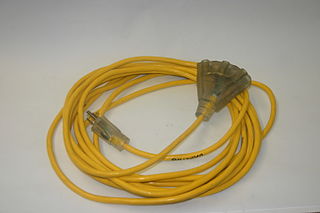 W
WA power cable is an electrical cable, an assembly of one or more electrical conductors, usually held together with an overall sheath. The assembly is used for transmission of electrical power. Power cables may be installed as permanent wiring within buildings, buried in the ground, run overhead, or exposed. Power cables that are bundled inside thermoplastic sheathing and that are intended to be run inside a building are known as NM-B.
 W
WAn aerial cable or air cable is an insulated cable usually containing all conductors required for an electrical distribution system or a telecommunication line, which is suspended between utility poles or electricity pylons. As aerial cables are completely insulated there is no danger of electric shock when touching them and there is no requirement for mounting them with insulators on pylons and poles. A further advantage is they require less right of way than overhead lines for the same reason. They can be designed as shielded cables for telecommunication purposes. If the cable falls, it may still operate if its insulation is not damaged.
 W
WCopper has been used in electrical wiring since the invention of the electromagnet and the telegraph in the 1820s. The invention of the telephone in 1876 created further demand for copper wire as an electrical conductor.
 W
WCopper-clad aluminium wire is an electrical conductor composed of an inner aluminium core and outer copper cladding.
 W
WElectrical wiring is an electrical installation of cabling and associated devices such as switches, distribution boards, sockets, and light fittings in a structure.
 W
WAn extension cord (US), power extender, drop cord, or extension lead (UK) is a length of flexible electrical power cable (flex) with a plug on one end and one or more sockets on the other end. The term usually refers to mains extensions but is also used to refer to extensions for other types of cabling. If the plug and power outlet are of different types, the term "adapter cord" may be used. Most extension cords range from around two to thirty feet in length although they are made up to 300 feet in length.
 W
WA high-voltage cable is a cable used for electric power transmission at high voltage. A cable includes a conductor and insulation. Cables are considered to be fully insulated. This means that they have a fully rated insulation system that will consist of insulation, semi-con layers, and a metallic shield. This is in contrast to an overhead line, which may include insulation but not fully rated for operating voltage. High-voltage cables of differing types have a variety of applications in instruments, ignition systems, and alternating current (AC) and direct current (DC) power transmission. In all applications, the insulation of the cable must not deteriorate due to the high-voltage stress, ozone produced by electric discharges in air, or tracking. The cable system must prevent contact of the high-voltage conductor with other objects or persons, and must contain and control leakage current. Cable joints and terminals must be designed to control the high-voltage stress to prevent the breakdown of the insulation.
 W
WMineral-insulated copper-clad cable is a variety of electrical cable made from copper conductors inside a copper sheath, insulated by inorganic magnesium oxide powder. The name is often abbreviated to MICC or MI cable, and colloquially known as pyro. A similar product sheathed with metals other than copper is called mineral insulated metal sheathed (MIMS) cable.
 W
WA portable cord is a cable with multiple conductors used for temporary electrical power connections requiring flexibility. The cord can be employed in a range of applications, such as operating motors in small and large tools, equipment, power extensions, home appliances, and machinery.
 W
WA power cord, line cord, or mains cable is an electrical cable that temporarily connects an appliance to the mains electricity supply via a wall socket or extension cord. The terms are generally used for cables using a power plug to connect to a single-phase alternating current power source at the local line voltage. The terms power cable, mains lead, flex or kettle lead are also used. A lamp cord is a light-weight, ungrounded, single-insulated two-wire cord used for small loads such as a table or floor lamp.
 W
WRadio frequency power transmission is the transmission of the output power of a transmitter to an antenna. When the antenna is not situated close to the transmitter, special transmission lines are required.
 W
WA T-antenna, T-aerial, flat-top antenna, top-hat antenna, or (capacitively) top-loaded antenna is a monopole radio antenna with transverse capacitive loading wires attached to its top. T-antennas are typically used in the VLF, LF, MF, and shortwave bands, and are widely used as transmitting antennas for amateur radio stations, and long wave and medium wave AM broadcasting stations. They can also be used as receiving antennas for shortwave listening.
 W
WTeck cable is a type of low voltage armoured cable named for the location where it was first developed and used, Teck Township, now known as Kirkland Lake, Ontario. The mining operations such as those conducted by Teck-Hughes Gold Mining Ltd. required a durable cable to power equipment and withstand the demanding conditions, and teck cable was the engineered result.
 W
WTough rubber-sheathed cable is a type of cable which normally consists of a black outer sheath of rubber with several conductors inside. The rubber provides an abrasion-resistant, corrosion-resistant, waterproof, protective covering for an insulated electric cable.
 W
WTwin and earth cable is a colloquial name in the UK, Australia, New Zealand and other countries for a type of flat sheathed fixed mains electricity cable, containing two insulated current-carrying conductors and an Earth connector. In Australia and New Zealand this type of cable is referred to as 'Flat TPS', as well as "Twin and Earth" or "Twin with Earth".
 W
W